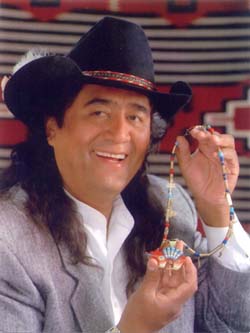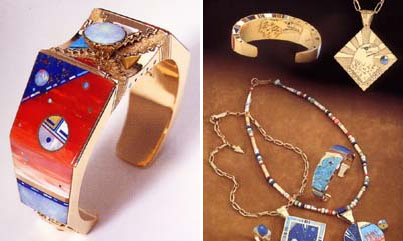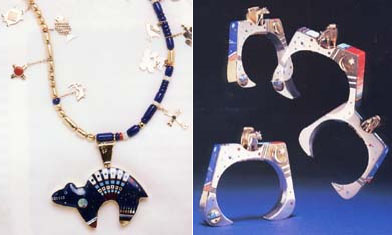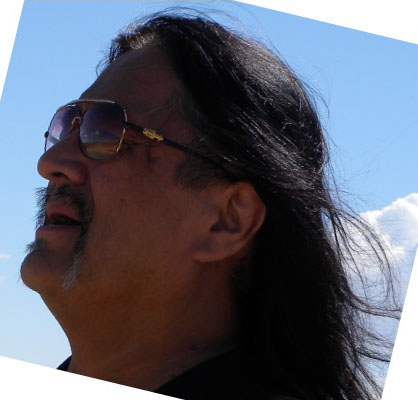quote:
Jesse Monongye 
Abandoned as an infant, Jesse Monongye did not know his father until he was twenty-one. Shortly thereafter, he began working with Preston Monongye, a contemporary of Hopi master Charles Loloma, who helped pioneer individual artistry among Native American jewelers. He learned jewelry making and discovered he had innate abilities. One year later, following a dream in which he was encouraged by his mother (whom he had never found) to focus these talents, Jesse became a full time jeweler. Today he is acclaimed for his incandescent, richly detailed jewelry.

"Navajos are branded with making squash blossoms and shadowbox jewelry - a lot of leaf work, heavy stamping, that kind of thing," Monongye explains. "Hopis are known for overlay with a satin finish, cut-out animals, kachinas dancing". Zunis, he says, are expected to stick with inlaid bird designs and carved fetishes.
Jesse's artwork does not fit into any of these categories. For one thing, the surface of his inlay is often carved three-dimensionally. An example is the Grand Tetons scene that won best in Lapidary at the Santa Fe Indian Market. Its lapis mountains were carved with ridges that glitter with pyrite inclusions, capped with white dolomite, and set into an already inlaid and buffed background. "The mountains look like one piece, until you look closely," he points out. There are actually 50 to 100 different stones cut and pieced together in the mountains alone. As with all of Jesse's work, the craftsmanship and artistry becomes more amazing the longer you look at it.

Raised on the Navajo Reservation by distant relatives, whom he calls Grandmother and Grandfather, Jesse was profoundly influenced by the old Navajo life-ways of discipline and beauty and by the teachings of his grandparents, respected tribal elders. At an early age, he was aware of the perfection and balance sought by the neighboring Two Grey Hills rug weavers in their work, and "the beautiful songs the women would sing as they wove". A vision he had during a Navajo Initiation Ceremony inspired his artistic style and helped him "to create better and better every day".
Jesse's and his father's designs blend influences from many tribes as well as other sources, expressing something beyond an individual's artistic identity. The work is the visible and tangible expression of a very broad abstraction: a spirituality that is both individual and cultural. "My father was more of an artist than craftsman… all things he touched, he mastered: sculpture, kachina carving, pottery, jewelry, zinc etchings". His father left a legacy. "The inlay is a way to prove that I am the best. It's important to have, not so much an idol, but someone you respect. In our society we're losing respect for our elders".
The elements of his work - color, pattern, and discipline - are indelibly linked to his Navajo roots, his religion, and the twisted, bumpy road of his own past. One senses that his approach has something to do with the nature of Navajo spirituality, what he refers to as "The Beauty Way".
"The Beauty Way" of the Navajo person touches everything. They look to their prayer life for the meaning of all things: night and day, rain and storm, their surroundings. The Indian talks about a circle. We dance in a circle, our homes are built in a circle, and our minds fall in circles. Beauty surrounds us in the heavens. If you divide these things in four directions, from east to north to west to south, you achieve a balance.
"It was instilled in me by my grandfather to be perfect… Why do something wrong and do it over again? Everything I do, I make sure of all the possible ways of not making a mistake, that it is durable and strong".
quote:
Jesse Monongya a Navajo / Hopi Indian Jeweler 
His jewelry is highly regarded as the finest inlay work accomplished today.
He currently lives in Scottsdale, Arizona, a center for American Indian art, and also close to the Hopi and Navajo Reservations.
Jesse Monongya
Monongya's work has ranged from the use of silver and simply cut turquoise and coral to the highly technical and intricate designs of the galaxies and heavens in lapis, jade, malachite, and diamonds set in gold. While his work had evolved over the years, the superb color combination and balance of design are consistently present.
Raised in New Mexico in the famous Navajo rug center of Two Gray Hills, Jesse learned early the perfection of the craft from watching the weavers and their pursuit of balance and technical perfection. The beautiful songs the women would sing as they wove and the soothing sound of the loom would stay with him as he began his work at the jeweler's bench years later. The stars the elders talked about looking up in that beautiful black sky of the Southwest would eventually be used in stunning array in the classic bracelets and pendants he is so well known for throughout the world.
Along with producing his own work, he has been actively involved in several facets of art. He assisted in the placing of historic and Monongye Bolocontemporary Native American jewelry in the permanent display at the Heard Museum. He also was the Artist in Residence at the Heard Museum during 1986-87, teaching and demonstrating the centuries old art of Navajo jewelry making.
Monongya's jewelry has been featured in a number of group and private exhibitions and is represented in both corporate and private collections, including collections of many other artists. He has won many awards at the major American Indian art shows throughout the Southwest.
Some of the major influences upon his work have been in varying degrees, Preston, his father, who he did not know until he was a grown man; his Hopi and Navajo background; (his grandfather being the much respected Hopi Elder David Monongya); his Navajo grandfather who taught him the respect of his environment and the old Navajo ways of discipline and the Beauty Way.
The Bear has been a symbol to Jesse as the Strength and Power of his "Dine" culture. The intricately inlaid bear takes so much concentration that he must take time in between to recover. He tells of the story when he was a very young boy with his grandfather and they came across a bear out in the mountains. His grandfather spoke to the bear in Navajo, acknowledging his strength and power, asking for blessing and to pass safely. The bear retreated from his standing position and walked away into the woods. It was a very strong experience for Jesse.
Through Jesse's skilled hands we can also share in these cultural and spiritual experiences.

 SMP Silver Salon Forums
SMP Silver Salon Forums

 Silver Jewelry
Silver Jewelry

 Jesse Monongye
Jesse Monongye




